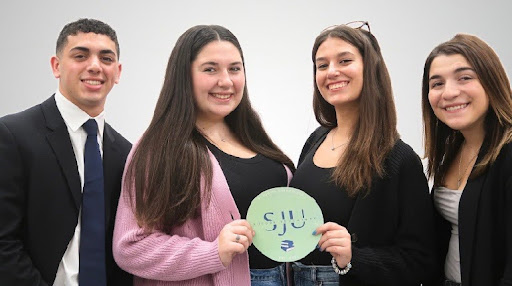
It’s no secret that group projects are not every student’s favorite kind of assignment. Some find it challenging to take on leadership roles, others find it hard to balance the work equally among a group and some students even get stuck doing the entire project alone. Does this dreaded, unwanted feeling surrounding group projects run through every St. John’s University student’s veins?
Various students shared their experiences with group projects — most of them having similar feelings of reluctance regarding the “inevitable unequal distribution of work,” as senior Ayah Cruzado said.
Senior Amal Ahmad shared sentiments similar to those of Cruzado’s. Ahmad does not enjoy group projects “because efforts are usually disproportionate and it’s hard to organize and ensure that all responsibilities are done well.”
“Group projects can be counter-productive due to the uneven amount of work each student may be doing on the project,” said senior Matthew Anderson. “One or two students may be doing a larger portion of the project compared to the others within the group.”
The uncertainty of the project’s guidelines and the assigned or unassigned group members play an additional role in the stress surrounding group projects in the classroom.
Ahmad shared that “depending on the prompt, I usually get annoyed when professors assign group projects.”
“If it is a randomized group, I’m a bit anxious and uncertain,” Cruzado said. “When the groups are pre-chosen, there is undoubtedly some awkward tip-toeing and an unequal workload for each member.”
Having shared that group projects can be immensely overwhelming and anxiety-inducing, students also shared the positives of group projects, including that collaboration can sometimes be highly productive.
Anderson notes that a significant benefit of group projects is the social activity it provides. “From group projects, I have learned how to collaborate and improve my social skills within the classroom. For some projects, you have to work with people you don’t know, forcing you to get out of your comfort zone socially and academically.”
Junior Kelly Mooney shares that group projects have helped her to collaborate better with classmates and to convey her opinion in a non-judgmental way.
“I am more comfortable [with group projects] when it comes to asking clarifying questions in smaller groups of my peers than I would in the grand scheme of a full class setting,” said Mooney. “I feel like I can convey my opinion in a more positive and less-staked manner.”
Cruzado expressed that when it comes to having the opportunity to work with other people, everyone can “contribute our different backgrounds and expertise into the work.” This is a massive benefit to group assignments, as many individuals bring unique skills and qualities to the table, providing balance for students excelling in areas where others may not.
Similarly, Mooney said that both the collaboration on a project as well as the social aspect are important: “Group projects allow me to get the name and contact information of someone I may not have otherwise met and gives me a social opportunity that normal lectures don’t present.”
In addition to having an open mind when working in groups, Cruzado reflects on the hardships of a personal group work experience: “I think my worst experience with a group [project] would be a science assignment. The work was distributed, and all parties agreed. However, when it came to actually showing what had been accomplished, I was the only one who had something to bring forth — it also didn’t help that my two fellow members were on bad terms before we were even placed together.”
Despite the difficulties that come with working alongside classmates, Cruzado said that her current “film course has assignments that are usually simple where we watch a movie and talk about scenes with our classmates that stood out to us. The nature of this work allows us to each interpret the material in our perspectives and share that so we feel mentally stimulated and included in the work.”
When it comes to going into group projects with a positive mindset, Cruzado added that “being open and communicating well helps ensure that you and your partner[s] are always on the same page.” Ahmad expressed similar sentiments, saying, “Communication is key — so is doing your part and doing it well so that you don’t make other people’s lives more stressful.”
For students who struggle with group projects, Mooney and Anderson shared what aids them in successfully maneuvering these assignments.
“I think it is important to divide the work evenly and to let people express what part of the project they want to work on,” said Mooney. “That simple discussion at the beginning of a group project can help everyone feel included and give everyone a sense of responsibility.”
“Create a group chat amongst the group and set guidelines and roles for how you may split up the work for the project,” says Anderson. “If the expectations for the project are outlined early, it is more likely that most of the work will not be left to one or two students.”
From keeping an open mind to taking on a leadership role to ensure all the work gets done equally, SJU students use varying tactics to tackle the dreaded group project. Group projects are often feared, but they don’t have to be — especially when viewing them as an exciting challenge, not an impossible task.







